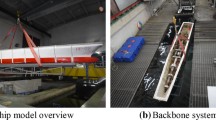Abstract
Design rules for very large seagoing vessels are undergoing changes owing to the hydroelasticity of the ship. The hydroelasticity of the ship is in the form of wave-induced vibrations such as springing and whipping, which are known to aggravate fatigue and extreme loads. The present study deals with a method for the estimation of extreme loads. The method consists of a preliminary analysis of linear responses of motions and loads, and a sequential analysis of the nonlinear extreme load. First, a full-time series of the linear response is obtained using response amplitude operators and wave spectra. Next, the candidate waves of extreme event are extracted from the full-time series based on the linear response. The linear response may be a motion or a load depending on the target value of the sequential analysis. Finally, the sequential analysis is conducted using a fully coupled model of the three-dimensional Rankine panel method, three-dimensional finite-element method, and two-dimensional generalized Wagner model with the candidate waves. The method is validated for a nonlinear hogging moment in a short-term sea state and applied for a long-term prediction of an extreme hogging moment on an ultra-large containership. The extreme values of linear and nonlinear loads are compared in terms of the most probable value and probabilistic distribution.



















Similar content being viewed by others
References
Storhaug G, Kahl A (2015) Full scale measurements of torsional vibrations on Post-Panamax container ships. In: Proceedings of the 7th international conference on hydroelasticity in marine technology, Split
Ki HG, Park SG, Jang IH (2015) Full scale measurement of 14k TEU container ship. In: Proceedings of the 7th international conference on hydroelasticity in marine technology, Split
Im HI, Vladimir N, Malenica S, Ryu HR, Cho DS (2015) Fatigue analysis of HHI SkyBenchTM 19000 TEU ultra large container ship with springing effect included. In: Proceedings of the 7th international conference on hydroelasticity in marine technology, Split
Oberhagemann J, Shigunov V, Radon M, Mumm H, Won SI (2015) Hydrodynamic load analysis and ultimate strength check of an 18000 TEU containership. In: Proceedings of the 7th international conference on hydroelasticity in marine technology, Split
Hwang JH, Park JS, Won SI, Jung BH (2015) Ultimate strength assessment of ultra large container ships considering hydroelastic responses. In: Proceedings of the 7th international conference on hydroelasticity in marine technology, Split
Kim JH, Kim Y (2014) Numerical analysis on springing and whipping using fully-coupled FSI models. Ocean Eng 91:28–50
Kim JH, Kim Y, Yuck RH, Lee DY (2015) Comparison of slamming and whipping loads by fully coupled hydroelastic analysis and experimental measurement. J Fluid Struct 52:145–165
Kim Y, Kim JH, Kim Y, Lee DY, Jung BH (2015) Development of computational methods and application procedure for ship structural hydroelasticity and fatigue assessment in ocean waves. In: Proceedings of World Maritime Technology Convention 2015, Rhode Island
Torhaug R (1996) Extreme response analysis of non-linear ocean structures: identification of minimal stochastic wave input for time domain simulation. PhD Dissertation, Department of Civil Engineering, Standford University, California
Rice O (1944) Mathematical analysis of random noise. Bell Syst Tech J 23:282–332
Rice O (1945) Mathematical analysis of random noise. Bell Syst Tech J 24:45–156
Cartwright DE, Longuet-Higgins MS (1956) The statistical distribution of the maxima of a random function. Proc R Soc Lon Ser A Math Phys Sci 237(1209):212–232
DNVGL (2015) Design of offshore steel structures, general—LRFD method. DNVGL-OS-C101
DNV (1992) Structural reliability analysis of marine structures. Classification Notes No. 30.6
Friis-Hansen P (1994) Reliability analysis of a midship Section. PhD Dissertation, Department of Naval Architecture and Offshore Engineering, Kgs. Lyngby
Tromans PS, Anatruk AR, Hagenmeijer P (1991) A new model for the kinematics of large ocean waves—application as a design wave. In: Proceedings of the first international offshore and polar engineering conference, vol. 3, pp 64–71
Troesch AW (1997) Study of the use of nonlinear time domain simulation in a design loads generator (DLG). Final Report to the American Bureau of Shipping
Adegeest LJM, Braathen A, Loseth RM (1998) Use of non-linear sea-loads simulations in design of ships. In: Proceedings of 7th international symposium on practical design of ships and mobile units, Hague, pp 53–58
Dietz JS (2004) Application of conditional waves as wave episodes for extreme loads on marine structures. PhD Dissertation, Technical University of Denmark, Lyngby
Ochi MK (1973) On prediction of extreme values. J Ship Res 17:29–37
Winterstein SR, Ude TC, Cornell CA, Bjerager P, Haver S (1993) Environmental parameters for extreme response: Inverse FORM with omission factors. In: Proceedings of 6th international conference on structural safety and reliability, Innsbruck
Baarholm GS, Moan T (2000) Estimation of nonlinear long-term extremes of hull girder loads in ships. Mar Struct 13(6):495–516
Zhao R, Faltinsen OM, Aarsnes JV (1996) Water entry of arbitrary 2-dimensional sections with and without flow separation. In: Proceeding of 21st symposium on naval hydrodynamics, Trondheim
Khabakhpasheva TI, Kim Y, Korobkin AA (2014) Generalized Wagner model of water impact by numerical conformal mapping. Appl Ocean Res 44:29–38
Okland OD, Moan T (1998) Prediction of slamming loads and extreme structural response for large twin hull vessels. In: Proceedings of the 8th international offshore and polar engineering conference, Montreal, pp 229–236
Acknowledgements
This study was carried out as part of a research project supported by LRFC [LRFC: Lloyd’s Register Foundation (LRF)-funded Research Center at SNU]. The support provided by LRFC is appreciated. In addition, the administrative supports of AMEC and RIMSE must be credited.
Author information
Authors and Affiliations
Corresponding author
About this article
Cite this article
Kim, JH., Kim, Y. Prediction of extreme loads on ultra-large containerships with structural hydroelasticity. J Mar Sci Technol 23, 253–266 (2018). https://doi.org/10.1007/s00773-017-0471-9
Received:
Accepted:
Published:
Issue Date:
DOI: https://doi.org/10.1007/s00773-017-0471-9




